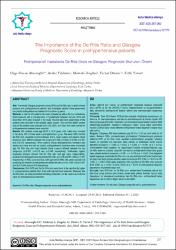| dc.description.abstract | Aim: To evaluate Glasgow prognostic score (GPS) and De Ritis ratio in optimal blood
pressure and prehypertensive patients, and investigate whether these parameters
can predict antihypertensive treatment in the follow-up period.
Methods: A total of 402 patients who were followed up with a 24-hour ambulatory
blood pressure with a pre-diagnosis of hypertension between January 2018 and
December 2018 were included in the study. Routine laboratory parameters of the
patients were recorded in the hospital digital system. The common health system
data of the patients was analyzed until June 2020, and those who were started on
antihypertensive treatment were recorded.
Results: 402 patients (mean age 40.16 ± 13.01 years, 49% male) were included
in the study. 226 of these were in prehypertension group. The mean GPS and the
De Ritis ratio, aspartate aminotransferase levels, mean systolic and diastolic blood
pressures were different between the groups (p=0.035, p=0.023, p=0.039, p<0.001
and p=0.012, respectively). When patients whose antihypertensive treatment was
started and those who did not receive antihypertensive treatment were compared;
age, De Ritis ratio and mean diastolic blood pressure differed between the two
subgroups (p<0.001, p=0.015 and p=0.040, respectively). Multivariate logistic
regression analysis showed that De Ritis ratio and age were, independently,
predictors for antihypertensive treatment (OR:3.064, p=0.015 and OR:1.050, p= 0.001
respectively). In ROC curve analysis, both age and De Ritis ratio were successful at
predicting the initiation of antihypertensive treatment with an AUC:0.697 and p<0.001
and AUC:0.630 and p=0.018 respectively.
Conclusions: Both GPS and the De Ritis ratio were found to be significantly higher
in prehypertensive patients than those with optimal blood pressure. Moreover, the
De Ritis ratio, an easily calculated laboratory parameter, can be used as a predictive
value for antihypertensive treatment. | en_US |


















